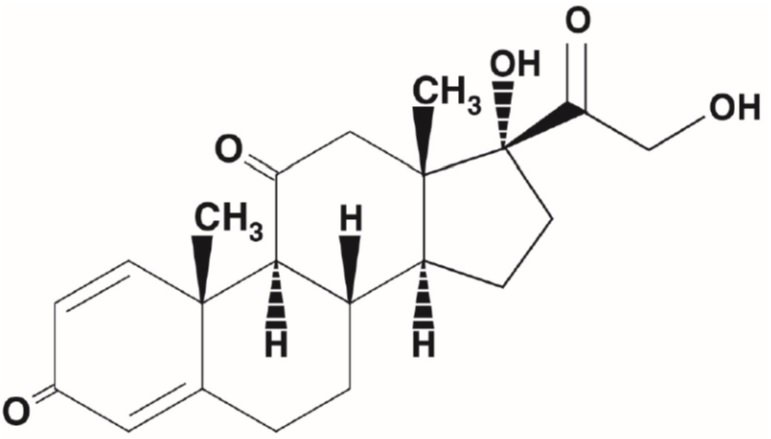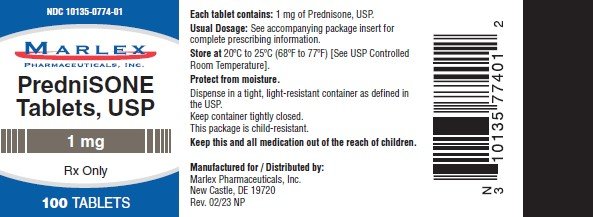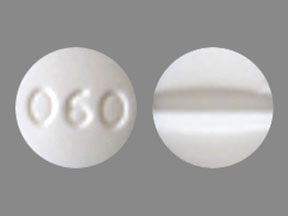Prednisone: Package Insert / Prescribing Info
Package insert / product label
Dosage forms: tablets, oral solution, oral solution, concentrate
Drug class: Glucocorticoids
J Code (medical billing code): J7512 (Per 1 mg, oral)
Medically reviewed by Drugs.com. Last updated on Oct 21, 2024.
On This Page
Prednisone Description
Prednisone Tablets, USP contain prednisone which is a glucocorticoid. Glucocorticoids are adrenocortical steroids, both naturally occurring and synthetic, which are readily absorbed from the gastrointestinal tract. The chemical name for prednisone is pregna-1,4-diene-3,11,20-trione, 17,21-dihydroxy-. The structural formula is represented below:

Molecular Formula: C 21H 26O 5
Molecular Weight: 358.44
Prednisone is a white or almost white crystalline powder. It is slightly soluble in acetone, ethanol, ethylacetate and methanol.
Prednisone Tablets, USP 1 mg are available for oral administration containing 1 mg of prednisone, USP. Each tablet contains the following inactive ingredients: lactose monohydrate, magnesium stearate, microcrystalline cellulose, pregelatinized starch, sodium lauryl sulfate and sodium starch glycolate.
Meets USP Dissolution Test 2.
ACTIONS
Naturally occurring glucocorticoids (hydrocortisone and cortisone), which also have salt-retaining properties, are used as replacement therapy in adrenocortical deficiency states. Their synthetic analogs, such as prednisone, are primarily used for their potent anti-inflammatory effects in disorders of many organ systems.
Glucocorticoids, such as prednisone, cause profound and varied metabolic effects. In addition, they modify the body's immune response to diverse stimuli.
Indications and Usage for Prednisone
Endocrine disorders: primary or secondary adrenocortical insufficiency (hydrocortisone or cortisone is the first choice; synthetic analogs may be used in conjunction with mineralocorticoids where applicable; in infancy mineralocorticoid supplementation is of particular importance), congenital adrenal hyperplasia, nonsuppurative thyroiditis, hypercalcemia associated with cancer.
Rheumatic disorders: as adjunctive therapy for short-term administration (to tide the patient over an acute episode or exacerbation) in: psoriatic arthritis; rheumatoid arthritis, including juvenile rheumatoid arthritis (selected cases may require low-dose maintenance therapy); ankylosing spondylitis; acute and subacute bursitis; acute nonspecific tenosynovitis; acute gouty arthritis; posttraumatic osteoarthritis; synovitis of osteoarthritis; epicondylitis.
Collagen diseases: during an exacerbation or as maintenance therapy in selected cases of: systemic lupus erythematosus, acute rheumatic carditis.
Dermatologic diseases: pemphigus, bullous dermatitis herpetiformis, severe erythema multiforme (Stevens-Johnson syndrome), exfoliative dermatitis, mycosis fungoides, severe psoriasis, severe seborrheic dermatitis.
Allergic states: control of severe or incapacitating allergic conditions intractable to adequate trials of conventional treatment: seasonal or perennial allergic rhinitis, serum sickness, bronchial asthma, contact dermatitis, atopic dermatitis, drug hypersensitivity reactions.
Ophthalmic diseases: severe acute and chronic allergic and inflammatory processes involving the eye and its adnexa, such as: allergic conjunctivitis, keratitis, allergic corneal marginal ulcers, herpes zoster ophthalmicus, iritis and iridocyclitis, chorioretinitis, anterior segment inflammation, diffuse posterior uveitis and choroiditis, optic neuritis, sympathetic ophthalmia.
Respiratory diseases: symptomatic sarcoidosis, Loeffler's syndrome not manageable by other means, berylliosis, fulminating or disseminated pulmonary tuberculosis when used concurrently with appropriate antituberculous chemotherapy, aspiration pneumonitis.
Hematologic disorders: idiopathic thrombocytopenic purpura in adults, secondary thrombocytopenia in adults, acquired (autoimmune) hemolytic anemia, erythroblastopenia (RBC anemia), congenital (erythroid) hypoplastic anemia.
Neoplastic diseases: for palliative management of: leukemias and lymphomas in adults, acute leukemia of childhood.
Edematous states: to induce a diuresis or remission of proteinuria in the nephrotic syndrome, without uremia, of the idiopathic type or that due to lupus erythematosus.
Gastrointestinal diseases: to tide the patient over a critical period of the disease in: ulcerative colitis, regional enteritis.
Miscellaneous: tuberculous meningitis with subarachnoid block or impending block when used concurrently with appropriate antituberculous chemotherapy, trichinosis with neurologic or myocardial involvement.
In addition to the above indications, prednisone tablets are indicated for systemic dermatomyositis (polymyositis).
Warnings
In patients on corticosteroid therapy subjected to unusual stress, increased dosage of rapidly acting corticosteroids before, during, and after the stressful situation is indicated.
Corticosteroids may mask some signs of infection and new infections may appear during their use. There may be decreased resistance and inability to localize infection when corticosteroids are used.
Prolonged use of corticosteroids may produce posterior subcapsular cataracts, glaucoma with possible damage to the optic nerves, and mayenhance the establishment of secondary ocular infections due to fungi or viruses.
Usage in pregnancy: Since adequate human reproduction studies have not been done with corticosteroids, the use of these drugs in pregnancy, nursing mothers or women of childbearing potential requires that the possible benefits of the drug be weighed against the potential hazards to the mother and embryo or fetus. Infants born of mothers who have received substantial doses of corticosteroids during pregnancy should be carefully observed for signs of hypoadrenalism.
Average and large doses of hydrocortisone or cortisone can cause elevation of blood pressure, salt and water retention, and increased excretion of potassium. These effects are less likely to occur with the synthetic derivatives except when used in large doses. Dietary salt restriction and potassium supplementation may be necessary. All corticosteroids increase calcium excretion.
While on corticosteroid therapy patients should not be vaccinated against smallpox. Other immunization procedures should not be undertaken in patients who are on corticosteroids, especially on high doses, because of possible hazards of neurological complications and a lack of antibody response.
Persons who are on drugs which suppress the immune system are more susceptible to infections than healthy individuals. Chickenpox and measles, for example, can have a more serious or even fatal course in non-immune children or adults on corticosteroids. In such children, or adults who have not had these diseases, particular care should be taken to avoid exposure. How the dose, route, and duration of corticosteroid administration affects the risk of developing a disseminated infection is not known. The contribution of the underlying disease and/or prior corticosteroid treatment to the risk is also not known. If exposed to chickenpox, prophylaxis with varicella-zoster immune globulin (VZIG) may be indicated. If exposed to measles, prophylaxis with pooled intramuscular immunoglobulin (IG) may be indicated. (See the respective package inserts for complete VZIG and IG prescribing information.) If chickenpox develops, treatment with antiviral agents may be considered.
The use of prednisone tablets in active tuberculosis should be restricted to those cases of fulminating or disseminated tuberculosis in which the corticosteroid is used for the management of the disease in conjunction with an appropriate antituberculous regimen.
If corticosteroids are indicated in patients with latent tuberculosis or tuberculin reactivity, close observation is necessary as reactivation of the disease may occur. During prolonged corticosteroid therapy, these patients should receive chemoprophylaxis.
Precautions
INFORMATION FOR PATIENTS
Persons who are on immunosuppressant doses of corticosteroids should be warned to avoid exposure to chickenpox or measles. Patients should also be advised that if they are exposed, medical advice should be sought without delay.
General: Drug-induced, secondary adrenocortical insufficiency may be minimized by gradual reduction of dosage. This type of relative insufficiency may persist for months after discontinuation of therapy; therefore, in any situation of stress occurring during that period, hormone therapy should be reinstituted. Since mineralocorticoid secretion may be impaired, salt and/or a mineralocorticoid should be administered concurrently.
There is an enhanced effect of corticosteroids in patients with hypothyroidism and in those with cirrhosis.
Corticosteroids should be used cautiously in patients with ocular herpes simplex because of possible corneal perforation.
The lowest possible dose of corticosteroid should be used to control the condition under treatment, and when reduction in dosage is possible, the reduction should be gradual.
Psychic derangements may appear when corticosteroids are used, ranging from euphoria, insomnia, mood swings, personality changes, and severe depression to frank psychotic manifestations. Also, existing emotional instability or psychotic tendencies may be aggravated by corticosteroids.
Aspirin should be used cautiously in conjunction with corticosteroids in hypoprothrombinemia.
Steroids should be used with caution in: nonspecific ulcerative colitis, if there is a probability of impending perforation, abscess or other pyogenic infection; diverticulitis; fresh intestinal anastomoses; active or latent peptic ulcer; renal insufficiency; hypertension; osteoporosis; and myasthenia gravis.
Growth and development of infants and children on prolonged corticosteroid therapy should be carefully observed.
Adverse Reactions/Side Effects
Fluid and electrolyte disturbances: sodium retention, fluid retention, congestive heart failure in susceptible patients, potassium loss, hypokalemic alkalosis, hypertension.
Musculoskeletal: muscle weakness, steroid myopathy, loss of muscle mass, osteoporosis, vertebral compression fractures, aseptic necrosis of femoral and humeral heads, pathologic fracture of long bones.
Gastrointestinal: peptic ulcer with possible perforation and hemorrhage, pancreatitis, abdominal distention, ulcerative esophagitis.
Dermatologic: impaired wound healing, thin fragile skin, petechiae and ecchymoses, facial erythema, increased sweating, may suppress reactions to skin tests.
Neurological: convulsions, increased intracranial pressure with papilledema (pseudotumorcerebri) usually after treatment, vertigo, headache.
Endocrine: menstrual irregularities; development of cushingoid state; suppression of growth in children; secondary adrenocortical and pituitary unresponsiveness, particularly in times of stress, as in trauma, surgery or illness; decreased carbohydrate tolerance; manifestations of latent diabetes mellitus; increased requirements of insulin or oral hypoglycemic agents in diabetics.
Ophthalmic: posterior subcapsular cataracts, increased intraocular pressure, glaucoma, exophthalmos.
Metabolic: negative nitrogen balance due to protein catabolism.
Prednisone Dosage and Administration
Dosage of prednisone tablets should be individualized according to the severity of the disease and the response of the patient. For infants and children, the recommended dosage should be governed by the same considerations rather than strict adherence to the ratio indicated by age or body weight.
Hormone therapy is an adjunct to, and not a replacement for, conventional therapy.
Dosage should be decreased or discontinued gradually when the drug has been administered for more than a few days.
The severity, prognosis, expected duration of the disease, and the reaction of the patient to medication are primary factors in determining dosage.
If a period of spontaneous remission occurs in a chronic condition, treatment should be discontinued.
Blood pressure, body weight, routine laboratory studies, including two-hour postprandial blood glucose and serum potassium, and a chest X-ray should be obtained at regular intervals during prolonged therapy. Upper GI X-rays are desirable in patients with known or suspected peptic ulcer disease.
The initial dosage of prednisone may vary from 5 mg to 60 mg per day, depending on the specific disease entity being treated. In situations of less severity lower doses will generally suffice, while in selected patients higher initial doses may be required. The initial dosage should be maintained or adjusted until a satisfactory response is noted. If after a reasonable period of time there is a lack of satisfactory clinical response, prednisone should be discontinued and the patient transferred to other appropriate therapy. IT SHOULD BE EMPHASIZED THAT DOSAGE REQUIREMENTS ARE VARIABLE AND MUST BE INDIVIDUALIZED ON THE BASIS OF THE DISEASE UNDER TREATMENT AND THE RESPONSE OF THE PATIENT.After a favorable response is noted, the proper maintenance dosage should be determined by decreasing the initial drug dosage in small decrements at appropriate time intervals until the lowest dosage which will maintain an adequate clinical response is reached. It should be kept in mind that constant monitoring is needed in regard to drug dosage. Included in the situations which may make dosage adjustments necessary are changes in clinical status secondary to remissions or exacerbations in the disease process, the patient's individual drug responsiveness, and the effect of patient exposure to stressful situations not directly related to the disease entity under treatment; in this latter situation it may be necessary to increase the dosage of prednisone for a period of time consistent with the patient's condition. If after long-term therapy the drug is to be stopped, it is recommended that it be withdrawn gradually rather than abruptly.
How is Prednisone supplied
Prednisone Tablets, USP 1 mgfor oral administration are supplied as follows:
White to off white round tablet, debossed with “056” on one side and scored on the other side, free from physical defects.
NDC 10135-0774-01 Bottle of 100 Tablets with child resistance caps
Store at20°C to 25°C (68°F to 77°F). [See USP Controlled Room Temperature.]
Protect from moisture.
Dispense in a tight, light-resistant container as defined in the USP.
Manufactured for/ Distributed by:
Marlex Pharmaceuticals, Inc.
New Castle, DE 19720
Rev. 02/23 NP
| PREDNISONE
prednisone tablet |
||||||||||||||||||
|
||||||||||||||||||
|
||||||||||||||||||
|
||||||||||||||||||
|
||||||||||||||||||
|
||||||||||||||||||
|
||||||||||||||||||
| Labeler - Marlex Pharmaceuticals, Inc. (782540215) |
Frequently asked questions
- What is considered a high dose of prednisone?
- Can you take prednisone with Keytruda?
- Is it OK to drink alcohol with Prednisone?
- What's a good prednisone taper schedule?
- How long can you take prednisone safely?
- Prednisone: What are 12 Things You Should Know?
- How long does it take for prednisone to work?
- Do I take all 6 prednisone pills at once on the first day?
- How long does prednisone stay in your system?
More about prednisone
- Check interactions
- Compare alternatives
- Pricing & coupons
- Reviews (862)
- Drug images
- Side effects
- Dosage information
- Patient tips
- During pregnancy
- Support group
- Drug class: glucocorticoids
- Breastfeeding
- En español


